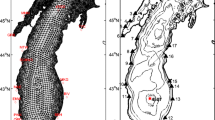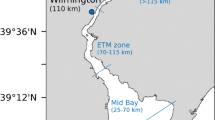Abstract
In order to simulate the response of the primary production dynamics to the decay of the Warm-Core Ring (WCR) 86-B off the east coast of Japan, we made a numerical model which consists of a three dimensional physical model (modified GCM) and we used the same biological model that Frankset al. (1986) did. According to the three dimensional model, the well known sub-surface chlorophyll maximum was reproduced but horizontal distributions of Chl.a and NO3 −-N showed different patterns corresponding to different initial conditions of nutrient. This is because the weak vertical velocity in the WCR does not play an important role on the ecosystem but only the light intensity and the balance between uptake and vertical diffusion of dissolved nutrient is important. This result differs from that of Frankset al. (1986). The two WCRs interaction model suggests that a weak upwelling could exist between two WCRs accompanied by baroclinic instability.
Similar content being viewed by others
References
Franks, P. J. S., J. S. Wroblewski and G. R. Flierl (1986): Prediction of phytoplankton growth in response to the frictional decay of a warm-core ring.J. Geophys. Res.,C6, 7603–7610.
Hakodate Marine Observatory (1986, 1987, 1988): Oceanographic Observation Report of the Hakodate Marine Observatory. Vol. 24, 25, 26.
Kawai, H. and S. Saitoh (1986): Secondary fronts, warm tongues and warm streamers of the Kuroshio Extension system.Deep-Sea Res.,33, 1487–1507.
Kawasaki, Y. and T. Sugimoto (1984): Experimental studies on the formation and degeneration processes of the Tsugaru warm gyre. p. 225–238. InOcean Hydrodynamics of the Japan and East China Seas, Elsevier Sci. Pub., Amsterdam.
Li, K. and T. Sugimoto (1989): Distribution and variation of nutrients and chlorophyll in warm core ring.Gekkan Kaiyo (mon. Oceanogr.),21, 729–737 (in Japanese).
Sugimoto, T. and H. Tameishi (1992): Warm-core rings, streamers and their role on the fishing ground formation around Japan.Deep-Sea Res.,39, Suppl. 1, S183-S201.
Sugimoto, T., Y. Kawasaki and J. Li (1992): A description of the time-dependent hydrographic structure of the warm streamer around the Kuroshio warm-core ring 86B.Deep-Sea Res.,39, Suppl. 1, S77-S96.
Tranter, D. J., G. S. Leech and D. Airey (1983): Edge enrichment in an ocean eddy.Aust. J. Mar. Freshw. Res.,34, 665–680.
Yentch, C. S. and D. A. Phinney (1985): Rotary motions and convection as a means of regulating primary production in warm core rings.J. Geophys. Res.,90, 3237–3248.
Yasuda, I., K. Okuda and M. Hirai (1992): Evolution of a Kuroshio warm-core ring—variability of the hydrographic structure.Deep-Sea Res.,39, Suppl. 1, S131-S161.
Yoshimori, A. and M. J. Kishi (1994): Effects of interaction between two Warm-Core Rings on phytoplankton distribution.Deep-Sea Res.,41, 1039–1052.
Author information
Authors and Affiliations
Rights and permissions
About this article
Cite this article
Kishi, M.J. Prediction of phytoplankton growth in a Warm-Core Ring using three dimensional ecosystem model. J Oceanogr 50, 489–498 (1994). https://doi.org/10.1007/BF02235419
Received:
Revised:
Accepted:
Issue Date:
DOI: https://doi.org/10.1007/BF02235419




